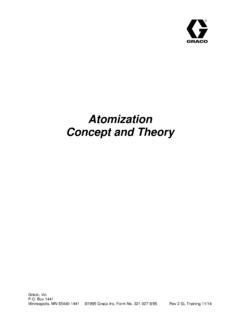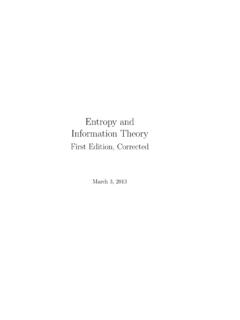Transcription of Information Processing Theory. - ed
1 ** * * * * **~** \l EB!_C I DOCUMEt~T RESUME ED 293 792 SP 030 007 AUTHOR Slate, John R.; Charlesworth, John R., Jr. TITLE Information Processing theory : Classroom Applications. PUB DATE [88] NOTE 17p. PUB TYPE Reports -Descriptive (141) EDRS PRICE MFOl/PCOl Plus Postage. DESCRIPTORS Advance Organizers; Attention Span; *Cognitive Processes; Cognitive Psychology; Elementary Secondary Education; *Instructional Improvement; *Learning Strategies; *Learning Theories; Memory; *Teaching Methods ABSTRACT The Information Processing model, a theoretical framework of how humans think, reason, and learn, views human cognitive functioning as analcgous to the operation of a computer. This paper uses the increased understanding of the Information Processing model to p4ovide teachers with suggestions for improving the teaching-learning process.
2 Major theoretical concepts in cognitive psychology are explained and specific ways to utilize each concept are delineated. These concepts are (1) attention; (2) active learning; (3) meaningfulness; (4) organization; (5) advance organizers; (6) memory aids; (7) overlearning; and (8) automaticity. A number of suggestions are provided as to how teachers can incorporate more of the new knowledge gained from the Information Processing theory into their classrooms. In addition, the model provides a strong theoretical rationale supporting many traditional teaching technlques. (JD) Reproductions supplied by EDRS are the best that can be made from the original document. DEPARTMENT OF EDUCATION OffiCe of Edu<:ahonal Research and lmprovemenr EDUCATIONAL RESOURCES Information CENTER (ERIC) 0 Thos documenl has been reprOduced as r~e1ved from lhe l'ler~on or organ zatlon orrgmat ng L 0 Monor Changes have l>len made 10 omproverepr<>duchon qualoly.
3 Pomts or vteworOplniOnsstatedlnlhiSdocu menl do nor necessanly represenl ollocoal OERI posoloOn or pelocy 2 \l EB!_C ..----1 0 cVJ pkPzD-_ H .. <;, BEEN 1 Information Processing Information Processing theory : Classroom Applications John R. Slate Arkansas State University and John R. Charlesworth, Jr. Western Carolina University Running Head: CLASSROOM APPLICATIONS "PERMISSION TO REPRODUCE THIS MATERIAL GRANTED BY TO THE EDUCATIONAL RESOURCES Information CENTER (ERIC)." \l EB_LC 3 2 Information Processing ABSTRACT The Information Processing model, a theoretical framework of how humans learn and remember, has been developed enough to provide teachers with suggestions for Improving the teaching-learning process.
4 Major theoretical concepts in cognitive psychology are explained and specific ways to utilize each concept are delineated. 3 \l EB_LC 4 Information Process1ng Information Processing theory : Classroom Applications During the past decade, cognitive psychologists have obtained an increased understanding of how humans think, reason, and learn. Much of this gain can be attributed to the continuing development of a theoretical framework known as the Information Processing model of human memory <Anderson, 1985; Atkinson &Shiffrin, 1968; Craik &Lockhart, 1972; Gagne, 1985>. This model, ascribed to by the maJority of American psychologists, views human cognitive functioning as analogous to the operation of a computer.
5 Our purpose in writing this paper is to utilize the increased understanding of the Information Processing model to provide teachers with suggestions for improving the teaching-learning process. MaJor theoretical concepts of att~ntion, active learning, meaningfulness, organization, advance organizers, memory aids, overlearning, and automaticity are mentioned, briefly explained, and then applications of each concept are specified. Attention Information that is not attended to does not enter into the Information Processing system <Gagne, 1985>. Without a student's attention to the task at hand, learning cannot occur. \l 5EB_LC 4 Information Processing Thus, attention is a necessary precursor for learning.
6 In order to focus student atte~~ion on the learning tasks, both effective motivational and classroom management skills are necessary <Kiausmeier, 1985). That is, educators need to create a set of techniques to attract and hold students' attention <Biehler & Sno,~an, 1986). The following procedures are recommended for increasing students' attention: <a> Use, but don't overuse, novelty when presenting material. A novel procedure becomes routine if used continually. <b> Move around the room, use gestures, and avoid speaking in a monotone. <c> Help students focus on the most important Information through voice inflection, pauses, writing on the board, or reviewing. <d> Cue students to material they will be asked to reproduce later by asking them to summarize the important points in a presentation.
7 <e> Ask students questions in a random manner. This enhances the probability that all students will be attentive. <f> When possible, eliminate any unnecessary distractions caused by lighting, noise, temperature, uncomfortable chairs, etc. (g) Make sure you have the students' attention prior to presenting Information . 5 \l 6EB!_C Information Processing Active Learning Research has demonstrated clearly that students learn best when they are act1vely involved in the learning process <Glover, Bruning, &Filbeck, 1983>. The value that the Information Processing model places upon a learner b~ing an active rather than a passive participant in the learning process is exempllf!ed by the humorous paraphrasing of an old adage by Rothkopf <1970, p.
8 325>, "You can lead a horse to water but the only water that gets into hls stomach is what he drinks. <a> To encourage active participation by students, teachers should talk iess, and spend more time using discussion, group activities, and individual activities and exercises in the classroom setting. <b> More activity by itsalf is inadequate to enhance learning. Cognitive effort must be expended for the class activity to be beneficial. Thus, students can be active during lecture and passive in discussion. Teachers who ask questions that require students to go beyond rote recall of facts are more likely to generate active discussion < , more cognitive effort~. <c> Another way to encourage the expenditure of cognitive energy is to grade assignments.
9 Students may not invest mental effort in a task unless they know it will be 1 .. \l 7EB_LC -------------- ! ___ __~--------------------- Information Processing 6 graded or has a good probability of be1ng evaluated. An example would be asking ex~ questions ever term paper top1cs to Increase the cognitive effort on the paper. <d> When v1ew1ng films or videotapes, students tend not to be mentally active unless they are cued to 1mportant issues and they know they will be tested on the material. Meaningfulness Meaningfulness is one of the most important elements of the Information Processing model. Research has indica~ed that when material is made meaningful, it is learned more rapidly and retained for longer periods of time than rote learning <Biehler &Snowman, 1986; Brown, 1975; Glover, Bruning &Filbeck, 1983; Lefrancois, 1985; Lindgren &Suter, 1980; Meacham, 1972; White & Gagne, 1976).
10 Meaningfulness occurs ~hen students are able to grasp generalizations, rules, relationships between facts, and principles for which they see some use; when they are able to associate new info~ation with their past knowledge and/or experiences; and, when Information is presented at the learner's level of understanding. Actions that classroom teachers can take to enhance meaningfulness are: <a> Show students how new Information is related to other material they have already learned. 7 \l 8EB_LC ----------~-------~~~ ~ --- -___,_ Info~mation Processing <b> Provide students with multiple examples for each new concept that illustrate both lnclusive and exclusive characteristics. <c> Use outlines, diagrams, analogies, examples, and demonstrations to assist in making th~ relationships between new and old Information clear.














